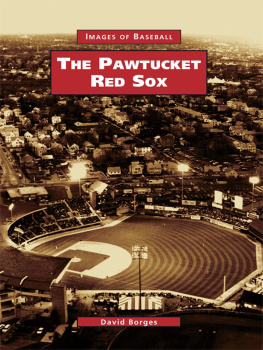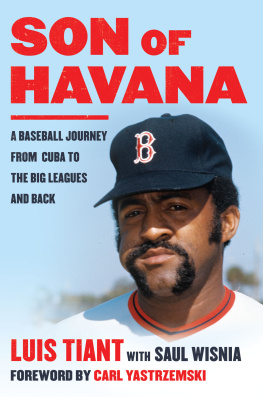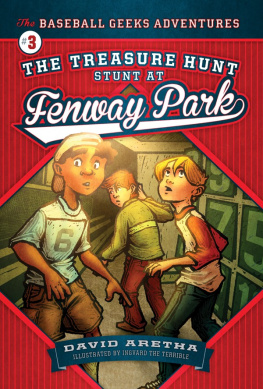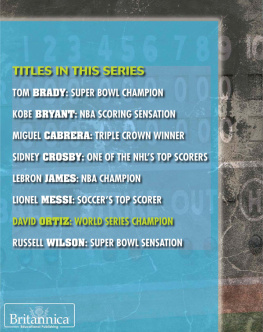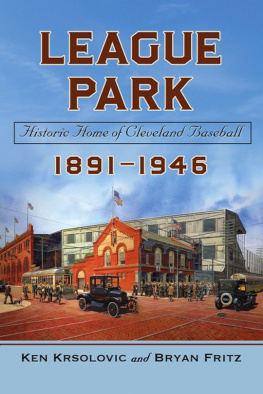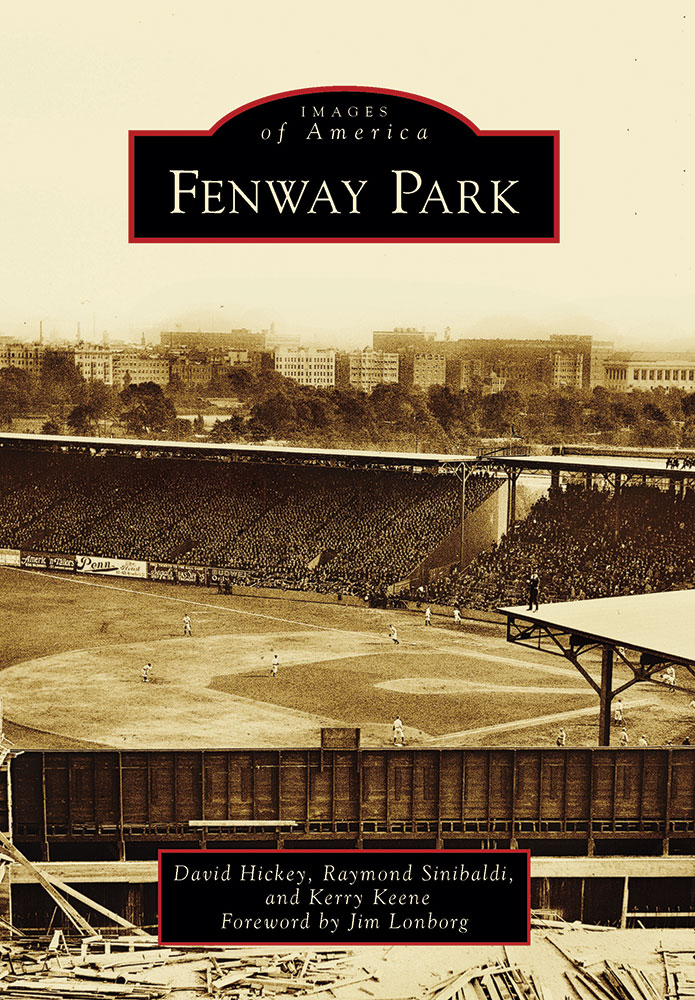
IMAGES
of America
FENWAY PARK

Sporting the years 1912 and 1934, this replica of the 1912 World Series program is painted on the brick wall behind the third-base grandstand at Fenway Park. The two years on the mural indicate the year Fenway Park was originally constructed and the year it was refurbished. The initial construction was done under the ownership of John I. Taylor, and the rebuilding took place after Tom Yawkey purchased the team in 1933. (Courtesy of the Boston Public Library.)
ON THE COVER: A lone figure stands on the third-base roof of Fenway Park taking in the 1914 World Series between the Boston Braves and Philadelphia Athletics. On the first-base roof a handful of men do the same. Shown in the distance is the area known simply as the Fens, from which the park derived its name. The building in the distance on the far right is the brand new Museum of Fine Arts, constructed in 1909. (Courtesy of the Boston Public Library.)
IMAGES
of America
FENWAY PARK
David Hickey, Raymond Sinibaldi,
and Kerry Keene
Foreword by Jim Lonborg

Copyright 2012 by David Hickey, Raymond Sinibaldi, and Kerry Keene
ISBN 978-0-7385-7688-6
Ebook ISBN 9781439642337
Published by Arcadia Publishing
Charleston, South Carolina
Library of Congress Control Number: 2011936768
For all general information, please contact Arcadia Publishing:
Telephone 843-853-2070
Fax 843-853-0044
E-mail
For customer service and orders:
Toll-Free 1-888-313-2665
Visit us on the Internet at www.arcadiapublishing.com
For Corey and our three wonderful children
Shawn, Sam, and McKenna.
David Hickey
And if they turn out good enough, I owe every
word to you. For Dad, Fenway, and 1967.
Raymond Sinibaldi
To Pam, I am forever grateful for your endless patience and support.
Kerry Keene
CONTENTS
I was a 23-year-old pitcher for the Red Sox when I saw Fenway Park for the first time. It looked like just an old brick building. I walked through the main entrance and then down through a drab, dark, dreary tunnel toward a stream of light. The light led me to the grandstand behind home plate. I walked up the ramp and there it was, in all its natural beauty, an incredible vision of a beautiful, green expanse that took my breath away.
Fenway Park was my baseball home for seven seasons, and although there were many exciting and memorable moments, nothing could top 1967. In that Impossible Dream season, we won the pennant by winning the last gameone of the happiest and most joyful days Fenway Park ever experienced. I was the pitcher that day, and the memories of that day and season have been passed down from grandfathers to fathers and grandmothers to mothers. Those of us who played on that team are afforded an elite place in the history of Fenway Park and the Red Sox. Yet Fenway Park and that day hold a special place in my heart for deeper personal reasons. As I toiled at Fenway Park, 17-year-old Rosemary Feeney was visiting Boston exploring college possibilities. She was staying at the Somerset Hotel downtown and knowing nothing of the Red Sox, Fenway Park, or Jim Lonborg, she was taken by the elation that emanated from Fenway and permeated the city. This joyful experience became a significant factor in her selecting the city of Boston in which to attend college. We met two years later. Today, after six children, six grandchildren, and 41 years of marriage, we remain happy Bostonians, owed, in part, to a magical day at Fenway Park.
Today, Fenway Park provides a wonderful family experience that goes beyond just a baseball game. When I return, I am welcomed by the staff, the ushers, and, most importantly, the fans with a warmth that makes me feel like I am heading into my living room to watch a game. Heres hoping that fans throughout New England, America, and indeed the world will be coming home to Fenway for a long, long time.
Jim Lonborg
Boston Red Sox, 19651971
Cy Young Award, 1967
This project could not have come together without the magnificent energy of so many. We extend a heartfelt thank you to: Jane Winton, Henry Scannell, and the photography staff at the Boston Public Library, for their dedication and professionalism; Jim Lonborg and Bill Buckner, for their time and recollections; Dan Rea, Fenway Park archivist; Josh Rogol of the Brockton Rox; Lynda Fitzgerald, for her eye, perspective, encouragement, and enthusiasm, NFhmyal; Steve Adamson, Steve Bronchuk, and Henry Martyniak whose passion for Fenway and the game proved an invaluable asset; Bill Nowlin, Bob Brady, and Dan Desrochers; John Galvin of Digital Image Fidelity, LLC, Whitman, Massachusetts, for his expert consultation; On Stage Theatre, Abington, Massachusetts, for the use of their studio space; the students and staff at Hanson Middle School, for their encouragement; Ryan Easterling, Lissie Cain, and the staff of Arcadia Publishing, for their patience and professionalism; Carolyn Geisler and Heather Rivero, for holding the fort, and the boys at the ranch, for their energy; baseball reference.com; retrosheet.org; fenwaypark100.org; and the Society for American Baseball Research (SABR) bio-project and all the generous, creative people, past and present, who shared their love for Fenway Park expressed in their photographs. Unless otherwise noted, all images appear courtesy of the Boston Public Library.
On June 24, 1911, businessman John I. Taylor announced his intention to build a new home for the Red Sox on nearly eight acres of land between Ipswich and Lansdowne Streets in the Back Bay section of Boston. Purchasing the land at a public auction in February, Taylor never dreamed that the new structure would remain one of the regions most historic and beloved destinations well into the 21st century. It has become as much a part of Bostons history as the Boston Tea Party, the Boston Massacre, and the Sons of Liberty, and it has joined the Old North Church, the Bunker Hill Monument, and the USS Constitution as iconic city landmarks.
In April 2012, Fenway Park turned 100 years old. A century has passed by, and some of the citys most poignant, historic, tragic, and joyous moments have played out on its stage. Curses have emerged, demons have hovered, battles have been fought, legends have been born, heroes have conquered and fallen, hearts have been broken, and Impossible Dreams have come true. Five generations of Bostonians have passed through the gates of these hallowed grounds. In the decades of the 1950s and 1960s, little boys were indoctrinated into the world of the Red Sox fan with ritualistic first visits in the company of their fathers and grandfathers. In that era of black and white television, this marked the first living color baseball experience for the baby boomer generation. During the 1970s and 1980s, little girls became just as much a part of the Fenway Park landscape. In the 21st century, Wally the friendly, furry Green Monster entertains and regales children on the field and in the stands. A foundation of loyal, true Red Sox fans, once dubbed the Fenway Faithful by Red Sox broadcaster Ned Martin, has blossomed into a Nation. In its first century, Fenway has been built and rebuilt, designed and redesigned; it has been burned, it has been scorned; it has been worshiped and adored; and like the toughness of the New Englanders who revere it, it has endured.
Next page

